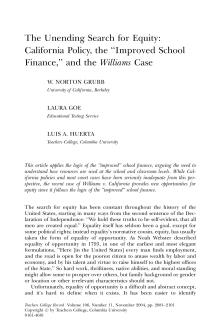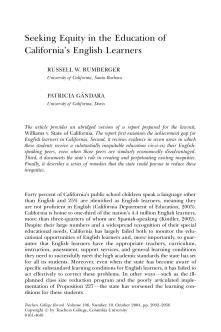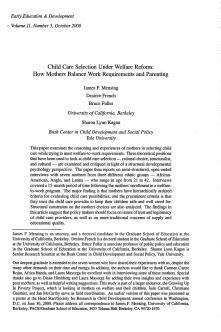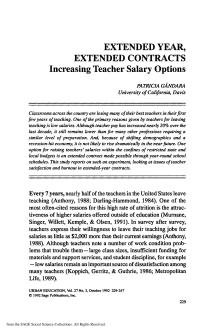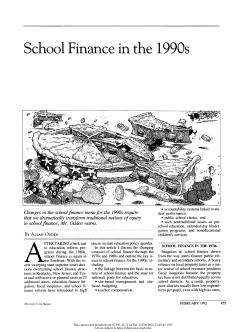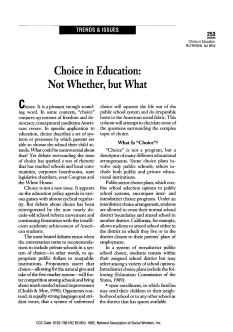School Finance and Governance in California
Published
Summary
Getting Down to Facts is an extensive investigation of CA's public education system commissioned by a bipartisan group of CA leaders. The project aimed to describe California's school finance and governance systems, identify obstacles hindering resource utilization, and estimate costs to achieve student outcome goals. The project resulted in 23 reports by scholars, which highlight that the current school finance and governance systems fail to help students achieve state performance goals, particularly those from low-income families. The reports provide a framework for assessing reform options.
Spinning Out the Implications of the Improved School Finance
Published
Summary
Despite the belief that increased spending leads to better educational outcomes, real expenditures per pupil have doubled since the late 1960s, yet problems in schools persist. An improved school finance approach focuses on effective resources in schools and classrooms that improve valued outcomes, rather than just increasing spending. Clarifying why funding is often wasted and developing new models of connections between revenues, resources, and the results of schooling is essential.
California Policy, the "Improved School Finance," and the Williams Case
Published
Summary
This article applies the logic of the ‘‘improved’’ school finance, arguing the need to understand how resources are used at the school and classroom levels. While California policies and most court cases have been seriously inadequate from this perspective, the recent case of Williams v. California provides new opportunities for equity since it follows the logic of the ‘‘improved’’ school finance.
Published
Summary
This article presents a summary of a report prepared for the Williams v. State of California lawsuit, highlighting the achievement gap for English learners in California and seven areas where they receive an inequitable education compared to their English-speaking peers. It also documents the state's role in perpetuating these inequities and proposes remedies to reduce them.
Published
Summary
This article discusses the role of childcare in promoting the development and opportunities for low-income children, noting that federal and state funding for childcare has increased dramatically since welfare reform. Despite this, children from poor households are less likely to be enrolled in high-quality programs than children from affluent families. To achieve welfare reform's goal of breaking the cycle of intergenerational poverty, welfare-to-work programs should increase access to high-quality childcare in low-income neighborhoods.
How Mothers Balance Work Requirements and Parenting
Published
Summary
This paper examines how mothers select childcare to meet welfare-to-work requirements. Interviews with seven mothers from different ethnic groups show that trust in childcare providers to keep their children safe is the most important criterion. Structural constraints on their choices are also analyzed. The findings suggest that policymakers should focus on trust and legitimacy of childcare providers in addition to supply and educational quality.
The Influence of Family Structure, Parental Practices, and Home Language
Published
Summary
Latino children are less likely to be enrolled in preschools, even after considering household income and maternal employment. Social factors such as language, child-rearing beliefs, and practices also impact center selection. African American families participate at higher rates, while lower enrollment for Latinos is linked to Spanish-speaking households and cultural preferences. Center selection is part of a broader parental agenda of acculturation to middle-class Anglo commitments to prepare children for school.
Published
Summary
The education productivity problem is rising resources but only modestly rising student achievement. Current education reform aims to produce higher student achievement with stable resources. Low student performance may be due to declining social and economic conditions, lack of hard work by students, and lack of parental support. However, research focuses on what schools can do to improve productivity by controlling and improving student achievement. Both education programs and finance structures need to be restructured to accomplish productivity challenges.
Increasing Teacher Salary Options
Published
Summary
Many new teachers leave the profession due to low salaries, which have only slightly increased despite requiring similar preparation to other professions. A possible solution is extended contracts made possible by year-round school schedules, which could raise salaries within restricted budgets. This study examines the effects of extended-year contracts on teacher satisfaction and burnout.
Published
Summary
School finance has become a prominent issue again due to court decisions and litigation in several states. This article explores school finance changes in the 70s and 80s and outlines key issues for the 90s, including the relationship between finance and education goals, site-based management, teacher pay, accountability, school choice, and nontraditional issues such as preschool and non-educational services for children.
Not Whether, But What
Published
Summary
Debate over school choice has been reignited due to the school reform movement and frustration with low academic achievement. The conversation becomes heated when private schools are included in the system of choice, as proponents believe it will foster competition and improve schools, while opponents argue it will harm public schools and society. This article aims to shed light on the complex issue of school choice.
California and Senate Bill 813
Published
Summary
In 1983, the California legislature enacted a series of incentive programs intended, in part, to encourage local school districts to devote more resources toward instructional expenditures. Analysis of district response to those incentives shows they were more effective in directing spending toward direct instruction than were general or categorical grants. However, it appears that as the incentive funds were rolled into general aid revenues, district spending patterns began to revert to the same distribution of expenditures observed prior to enactment of the incentives.
A Comparison of Education Reforms in the United States and Great Britain
Published
Summary
The new global economy is reshaping education worldwide, necessitating policies that expand access and enhance quality. Despite different educational systems, similar issues need to be addressed, resulting in an international convergence of education policies. The article discusses the emerging economy, educational challenges, policy alternatives, and compares recent reforms in the US and UK.


